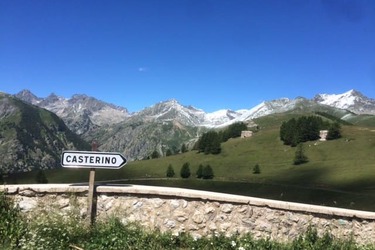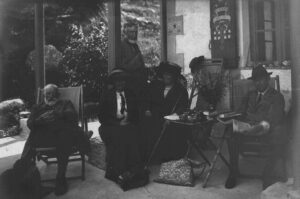 Castérino is today a hamlet of half a dozen hotels and assorted farms and houses in a beautiful flat valley at 1,565 metres altitude to the West of Tende. For many tourists, hikers, cyclists, skiers, archaeologists and botanist it is the favourite gateway to the Merveilles and the whole of the Mercantour area. The road from St Dalmas de Tende (on the highway from Bordighera to Tende and Cuneo) is well paved, and accessible all year (although chains are needed in winter). The location was called Casterine prior to 1946, being till then in Italy, at which time Clarence’s summer residence was one of the only big building.
Castérino is today a hamlet of half a dozen hotels and assorted farms and houses in a beautiful flat valley at 1,565 metres altitude to the West of Tende. For many tourists, hikers, cyclists, skiers, archaeologists and botanist it is the favourite gateway to the Merveilles and the whole of the Mercantour area. The road from St Dalmas de Tende (on the highway from Bordighera to Tende and Cuneo) is well paved, and accessible all year (although chains are needed in winter). The location was called Casterine prior to 1946, being till then in Italy, at which time Clarence’s summer residence was one of the only big building.
Clarence first went up to the Mont Bego area (now the Parc de Mercantour) only a couple of years after installing himself at Bordighera in 1881. He was pleased to find the rare Muscari botryonides plant but was also hoping to see some engravings which he had heard about from Moggridge, another English inhabitant of Bordighera. He did a day trip up from St Dalmas de Tende to the Valley de Merveilles but the late snow in June prevented him from finding any. In 1881 access from Bordighera would have been lengthy, but in 1883, just two years later, the first tunnel through the Alps, was opened, running for 3 kilometres under the Col de Tende. So travellers could make the journey by charabanc from Ventimiglia (just 5 kms West from Bordighera on the coast) to Tende in two hours. Clarence went again in 1885 and took rubbings of his first 50 figures.
It was not till 11 years later in 1897 later that Clarence chose to make Castérino the base for his studies. The drawing by Clarence, right, in the same year, shows how tiny the village was… and the drawing is titles by Clarence Our town in Val Casterino 11.7.97. He chose this small hamlet 85 kms north of Nice and accessible from St Dalmas de Tende 13 kms up into the mountains because of its ease of access to the Val Fontanalba. This valley leads down from the north east side of the Mont Bego and Clarence rightly presumed that the great flat orange brown rocks would have attracted whoever made the rock engravings.

Initially Clarence rented a house for his summer visits in Castérino from M. Pellegrino, but, as the house was sold in 1902, he decided to build his own house. He called it the “Casa Fontanalba” as it was just a 700 metre uphill climb to his favourite valley of the same name where he was eventually to record over 7,000 engravings. Designed by Robert Macdonald, it is quite different from local architecture, but rather of a British colonial style. It was laborious to build, as materials had to be brought from Tende by mule.
But it is the inside of the house which for many of Clarence’s followers represents the jewel in the crown of all Clarence’s work. Its interior walls and shutters are decorated throughout with his exquisite paintings. As he says: “As the house was built to enable us to continue our studies of the prehistoric rock figures in the valleys near, the half of which represent horns of various forms and sizes, and which without doubt had to the sculptors a special religious or symbolic meaning, horns have been painted in all part of the house, inside and out, to prevent the entrance of evil spirits and goblins…..Nearly every year some part of the house has been decorated with conventional representations of wild plants, and with proverbs and sentences, mostly in Esperanto”.
Clarence also made a garden, but not everything prospered with the short growing season. As one can see from his early drawings, Casterino was much more open than it is now, so he planted trees to provide protection. The fruit trees died but the larches and Scotch Firs did well and now disguise the Casa Fontanalba which is owned by the same d’Alberti family that loaned the land to Clarence over a century ago.
Now the flat valley on which Castérino lies is covered with larches and the village has become a cross country skiing centre with four or five hotels. The summer season is hardly any less busy with hikers coming to visit the valleys with the rock engravings and magnificent plants and flowers that Clarence first brought to prominence. The staff of the Parc de Mercantour have to work hard to prevent damage to both.
Accommodation in Castérino
| Chamois d’Or Tel: 0493 046 666 Web: www.hotelchamoisdor.net |
Auberge Marie Madeleine Tel 4 93 04 65 93 Web: www.casterino.com |
| Les Mélèzes Tel: 0493 049 595 Web: www.lesmelezes.fr |
Val Casterino Tel: 0493 046 438 Web: www.valcasterino.fr |